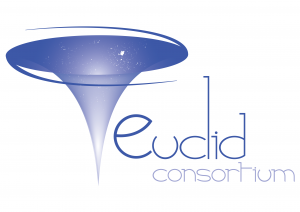The Euclid satellite, an M-class mission within ESA's Cosmic Vision Program, will use different complementary observations, in particular weak lensing and galaxy clustering, to unveil the nature of Dark Energy, and the laws of gravity at very large, cosmological scales.
The CosmoStat group is involved in the Euclid project at various levels, in particular:
- Management: We are involved in the organisation and management of various crucial activities within the Euclid Consortium.
- Data Analysis: Our group develops novel statistical tools to optimally extract cosmological information from the data accounting for the characteristics of the instruments, to provide the highest-quality science-ready products from the Euclid mission.
- Cosmological Interpretation: We contribute to the cosmological interpretation of the data in the framework of theoretical models of Dark Energy and Gravity.
The CosmoStat Euclid Team
- Leader of the Euclid organisation unit (OU) for level-3 (i.e. science ready) data
- Co-leader for activities regarding PSF Reconstruction
- Leader of the development of validation tools for External Data in the science-level data processing group.
- Co-leader in charge of validating Shear data and processing tools.
- Co-leader of the French Shear data processing activities.
- Co-Lead of the Forecast Inter Science Taskforce: Forecasts (IST:F)
- Co-Lead of the Forecast Inter Science Taskforce: Likelihood (IST:L)
- Editor in chief for Cosmology Review and Extended Forecasts (TWG)
- Representative of Euclid-France communication activities for the CEA
- Co-lead of the Work Package 6 of the Theory Working Group, in charge of cosmological parameter forecasts for models beyond the standard LCDM.
- Lead of Euclid's SC8 science data challenge for OU-LE3.
- Co-lead of the development of weak-lensing software for OU-LE3.
- Co-lead of activities regarding the combination of galaxy cluster probes with weak lensing.
- Consultant to IST:L on the development of CLOE, the official Euclid likelihood code.
Data Analysis
Within the Euclid Consortium, we coordinate the software development in the French science data centre producing the high-level output of the Euclid mission. Furthermore, we are involved in the development of the Euclid pipeline. In the following we briefly summarize some of the main CosmoStat contributions to the project.
Weak Lensing
Dark energy induces very subtle changes in the gravitational lensing distortion of galaxies. The shapes of those galaxies have to be measured with very high precision. This requires deep knowledge of the data, of the instrument characteristics, and of the shape measurement process. CosmoStat is developing an integrated pipeline, implementing new methodologies including:

- a superb correction of any distortion induced by the telescope and the optics, quantified by the point-spread function (PSF). We account for spatial, temporal, and wavelength-dependent variation of the PSF based on the subsampled star field.
- a deeper understanding of shape measurement techniques such as forward model fitting or moment-based techniques, facilitating the calibration of biases depending on galaxy morphology or measurement characteristics.
The resulting calibrated shear catalogue is then processed further using second- and higher-order statistical tools that we develop, to extract the full information contained in the data.
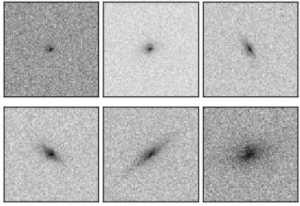
We further obtain dark-matter maps from weak-lensing data, using advanced statistical image analysis methods to account for missing data. These maps help to understand the distribution of matter in the cosmic web, and the still poorly-known relation between dark matter and galaxies.
Euclid will observe an unprecedented number of faint galaxies for weak lensing, two orders of magnitude more than for current surveys. The tools we develop need to be able to process such a large, unprecedented data volume, to allow for further cosmological exploitation, for example to constrain dark-energy models with the highest possible precision.
Galaxy Clusters
Galaxy clusters are the la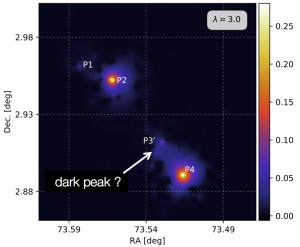 rgest bound objects in the Universe. They contain tens to thousands of galaxies, and are ideal laboratories to study the properties of the cosmic web. Our efforts in this area focus on methods to measure cluster masses with high precision using the weak-lensing distortion induced by those massive objects on background galaxies.
rgest bound objects in the Universe. They contain tens to thousands of galaxies, and are ideal laboratories to study the properties of the cosmic web. Our efforts in this area focus on methods to measure cluster masses with high precision using the weak-lensing distortion induced by those massive objects on background galaxies.
More generally, we also propose new methodologies and develop our own codes to process Euclid-like data.
Cosmological Interpretation
CosmoStat scientists are involved in different aspects of the cosmological analysis and interpretation of Euclid data. Our expertise ranges from the statistical analysis of the data using parameter inference tools, to the modeling of the Universe and its structures with dark energy and modified gravity.
Weak Lensing
We co-coordinate the Weak Lensing Science Working Group. This group develops methods of weak-lensing data analysis, computes the instrumental performance and survey characteristics that are necessary to achieve the science goals of Euclid, and interprets the Euclid data to measure cosmological parameters and models. Our work in this group focuses on the scientific analysis and study of statistical estimators of weak-lensing correlations, higher-order statistics, weak-lensing mass maps, and likelihood methods for parameter estimation.
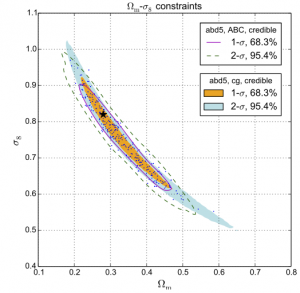
Forecasts
An important aspect of a large space mission such as Euclid is to make sure that the scientific goals can be reached with the planned instrumentation and survey strategy. CosmoStat scientists lead the forecasting of the Euclid performance, and assess Euclid’s power to constrain models of dark energy and modified gravity. We develop new theoretical models of the cosmic web, and include realistic instrumentation and astrophysical effects that might contaminate the data. Forecasts are done for both weak lensing, galaxy-galaxy lensing and spectroscopic galaxy clustering.
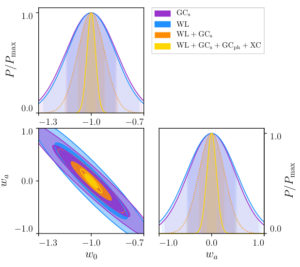
Theory and interpretation
We contribute significantly to the activities of the Theory Science Working Group, identifying and testing different theoretical models, estimating their predictions on observables via different numerical codes, We also coordinate the forecasting activity, and the review of Cosmology and Fundamental Physics [1].
Cross-correlations
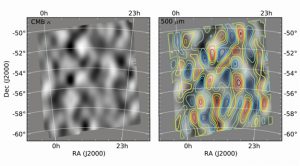
To make use of Euclid's multi-probe data, we study the combination of different cosmological observations, such as weak lensing, galaxy clustering, and galaxy clusters. The cross-correlation between different probes of cosmic structures on the same area of the sky can not be neglected when extracting information of the shape and evolution of the cosmic web. In fact, cross-correlation measurements can be seen as additional cosmological probe, and increase the constraining power. In addition to Euclid data, we also consider external data, for example CMB anisotropies from the Planck satellite, that will be cross-correlated with Euclid.


